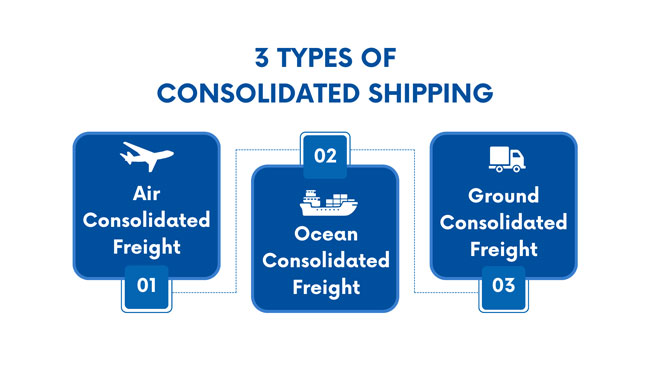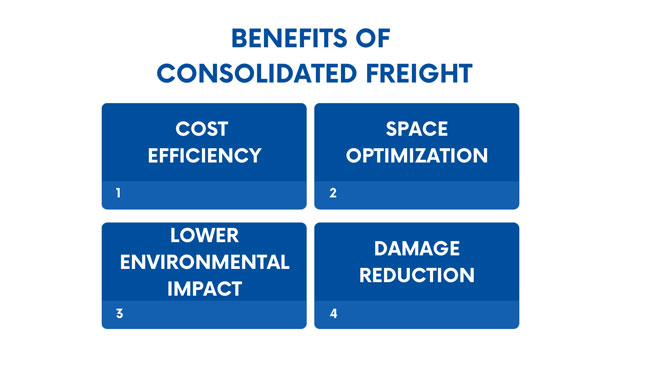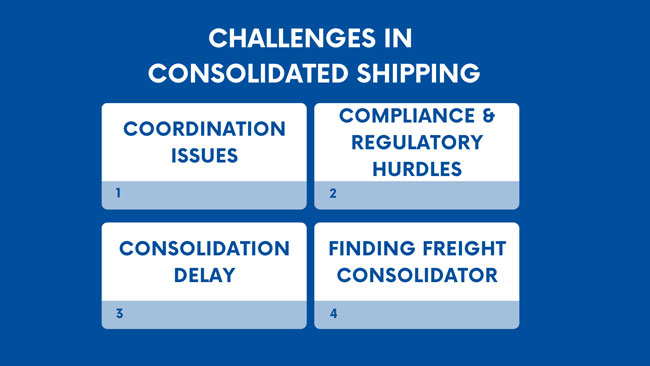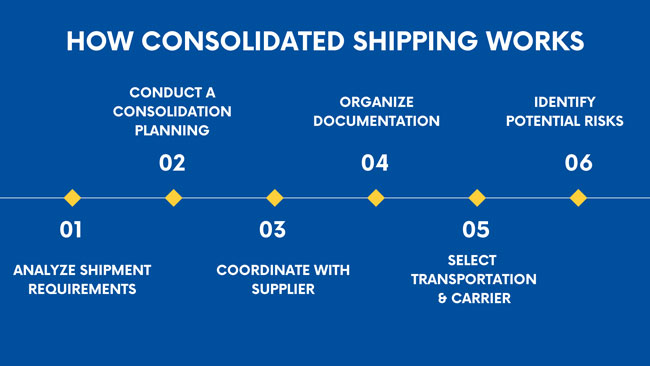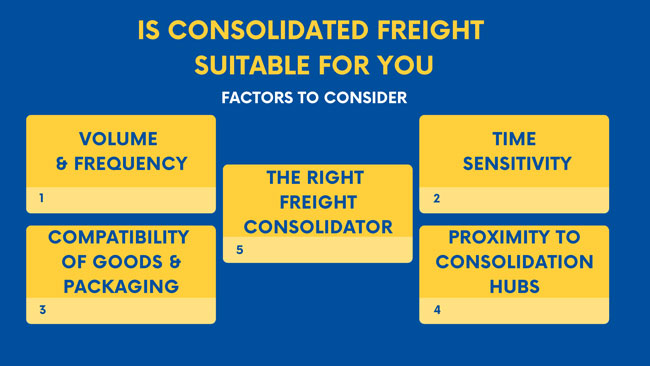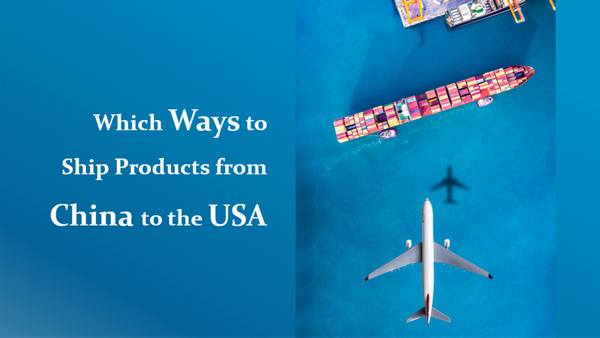How Consolidated Freight Boosts Efficiency and Cuts Costs
- Date:
- Author: SVI Content Team
- Share:
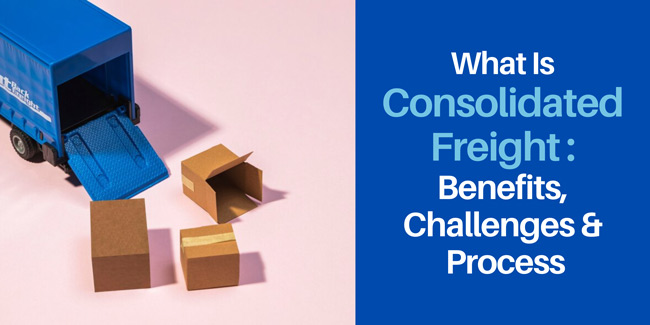
Consolidated freight refers to the practice of combining shipments from multiple sources into a single shipment. By grouping your goods with others, you can leverage the benefits of shared transportation. It’s a smart solution for businesses with smaller quantities of products.
In this guide, we will explore the concept of consolidated freight and disclose its importance, advantages, challenges, and solutions. Learn the ins and outs of consolidated freight and you’ll gain insight into how combining shipments can optimize your logistics operations.
So, join us on a journey to discover the ways in which freight consolidation can benefit your business!
Part 1. What is Consolidated Freight?
Consolidated freight, also known as consolidated shipping or cargo consolidation, is the process of combining smaller shipments from different companies that require less container space into a full shipment. The collected shipments are usually headed in the same direction.
Instead of shipping individually, these smaller shipments are grouped together, optimizing space and resources. This practice offers several advantages that can boost efficiency and cut costs for businesses.
How to ship consolidated freight? There are three main types of shipping consolidation, including:
Method 1. Air
Air freight consolidation involves combining multiple smaller shipments from different shippers into a larger, consolidated shipment transported by air. This method is ideal for time-sensitive shipments or when there is a need for faster transit.
Method 2. Ocean
Ocean freight consolidation is to combine smaller shipments into one large container transported by sea. The less-than-container load (LCL) will be consolidated into one 20′ or 40′ container (FCL). It is commonly used for international trade due to its cost-effectiveness and ability to handle larger volumes.
Method 3. Ground
Ground freight consolidation is transported by road, whether in trucks, trains or other ground vehicles. Less-than-truckload (LTL) is the option for it. It is commonly used for domestic shipments or shorter distances, offering flexibility and cost efficiency for businesses.
Next, let’s explore more.
Part 2. Benefits of Consolidated Freight
How can freight consolidation benefit you? The following are the advantages of consolidating your small shipment.
1. Cost Efficiency
Cost-benefit is the instant pro of cargo consolidation. If you have a small shipping cargo, it is cost-effective to share shipping costs with other suppliers rather than paying for a full container.
What’s more, consolidation means fewer individual shipments to handle. The reduction in handling translates to lower labor costs, thus optimizing the use of costs.
Example: If a supplier’s shipment only takes up a quarter of the container’s space, you might choose to ship it as LCL (Less than Container Load). However, by consolidating shipments from other factories, you can fill a full container. Shipping one full container (FCL) instead of several LCL shipments will significantly reduce freight costs.
2. Space Optimization
Small or less-than-full shipments can make better use of the available space in shipping containers. By sharing space with other suppliers’ orders, you are not going to pay for empty space.
For your warehouse, it can lead to a more organized and clutter-free storage environment because the product quantities are reduced while arriving at the warehouses and it is easier and efficient to manage its inventory.
3. Lower Environmental Impact
Make good use of transportation space can be beneficial to the environment as the eco-friend approach can contribute to a reduction in fuel consumption and greenhouse gas emissions.
4. Damage Reduction
Fewer touchpoints mean fewer opportunities for mishandling or accidents. Consolidated shipping is typically less handling of individual packages. This reduction in handling lowers the risk of damage, ensuring the good condition of your products.
Part 3. Challenges and Solutions in Consolidated Shipping
While consolidated freight offers numerous benefits, it also comes with its own set of challenges.
1. Coordination Issues
Order consolidation involves multiple parties: shippers, consolidators, and carriers. Everyone needs to be on the same page. If there is a lack of transparency or weak relationships among these roles, coordination issues may arise to disrupt the entire process.
Solutions:
- Build Strong Partnerships: Develop close relationships with consolidators and carriers to foster trust.
- Keep Communication Flowing: Establish clear communication channels and maintain regular contact for smooth coordination.
2. Compliance and Regulatory Hurdles
it is challenging to comply with all the necessary regulations and customs requirements of the exporting county when you consolidating different products from various suppliers.
Solutions:
- Proactive Documentation: Prepare all necessary documentation well in advance and make sure they are accurate and readily available for customs inspection.
- Expert Guidance: Collaborate with freight forwarders or customs brokers who specialize in international shipping.
- Stay Informed: Keep up-to-date on the latest regulations and trade agreements that might affect your shipments.
3. Consolidation Delay
Compared to direct shipping methods, consolidated freight may encounter delays. The need to wait for all individual shipments to arrive before consolidation, as well as potential stops for deconsolidation, can result in extended transit times.
Solutions:
- Advanced Planning: Plan your consolidation schedule and build in some flexibility to accommodate potential delays or last-minute changes.
- Strategic Stop Points: Choose consolidated shipments that have the same points to consolidate and de-consolidate.
- Real-Time Tracking: Leverage technology to track shipments in real-time.
4. Finding the Right Freight Consolidator
Not all freight consolidators are created equal. It is not easy to find and select a reliable and efficient consolidator who can handle your specific needs. Poor service can lead to delivery schedule dilemmas, damaged goods, and increased costs.
Solutions:
- Thorough Research: Conduct thorough research on potential freight consolidators. Look for a consolidator with experience and a strong reputation for customer satisfaction.
- Seek Recommendations: Ask for recommendations from other businesses or industry associations.
- Partner With Third-Party Service Providers: Engage with third-party service providers who have established relationships with a network of carriers.
Part 4. How Consolidated Shipping Works
If you don’t know how to start order consolidation. Let’s break down the process step by step.
Process Overview of Cargo Consolidations
1. Analyze Shipment Requirements
✔ Review your shipping needs: product types, volumes, weight, and any special handling requirements.
✔ Determine the origin and destination of the shipment, including any potential stops along the way.
2. Conduct a Consolidation Planning and Execution
✔ Set realistic delivery deadlines and consider any potential delays.
✔ Develop a detailed consolidation plan and wait to arrange transportation to bring the shipment to the location for consolidation.
✔ Communicate with all suppliers involved to ensure they are aware of the consolidation plan.
✔ Establish clear timelines and expectations for pick-up and delivery.
✔ Align pick-up schedules to facilitate smooth consolidation for consolidation on time
4. Organize Documentation and Customs Compliance
✔ Prepare all required documentation and customs paperwork in order.
✔ Double-check all documents for accuracy and completeness to avoid delays at customs.
✔ Work with freight forwarders or customs brokers to ensure compliance with all regulations.
5. Select Appropriate Transportation and Carrier
✔ Choose the best transportation method and carrier based on the consolidated shipment’s type, size, weight, and destination.
✔ Consider factors like cost, speed, and reliability.
6. Identify Potential Risks and Challenges
✔ Assess potential risks such as delays, damage, or regulatory issues.
✔ Develop backup plans to address these risks.
Part 5. Is Freight Consolidation Suitable for You?
Consolidated shipping isn’t a one-size-fits-all solution. Before jumping in, take the following factors into consideration to see if it’s the right fit for your business:
1. Volume and Frequency of Shipments
Evaluate the shipment volume and frequency to optimize your consolidation strategy.
2. Time Sensitivity
If your products can wait – having flexibility in the delivery schedule, they can be combined with other goods for shipments. Conversely, products require expedited delivery or have strict deadlines, cargo consolidation is not the best because of the extra time needed for consolidation.
3. Compatibility of Goods and Packaging Requirements
Consider the types, fragility, and packaging needs of your products. It’s better to combine shipments of similar goods that require specialized packaging. This helps minimize risks and streamline the handling process.
4. Geographic Proximity to Consolidation Hubs
Usually, consolidated shipments are typically routed through designated hubs for sorting, organization, and distribution. Assess the feasibility and cost of transporting your goods to these points. The closer your final destination is to the consolidation hub, the better you can streamline the process.
5. Choose the Right Freight Consolidator or Logistics Provider
An experienced freight consolidator is crucial for consolidated freight shipping. They can effectively handle the consolidation process and build connections with suppliers and carriers. Consider their network coverage, track record, expertise, and customer reviews to make an informed decision.
Conclusion
By sharing the container space with other goods, consolidated freight has the power to reduce transportation costs and streamline supply chains.
Whether you have low-volume orders or larger shipments, SVI Global is committed to finding the best solution for you. From inspections to transportation, we take care of every aspect of your consolidated cargo. Our own logistics team will work closely with you to analyze your shipping requirements, identify opportunities for consolidation, and implement a customized solution that delivers tangible benefits to your business.

